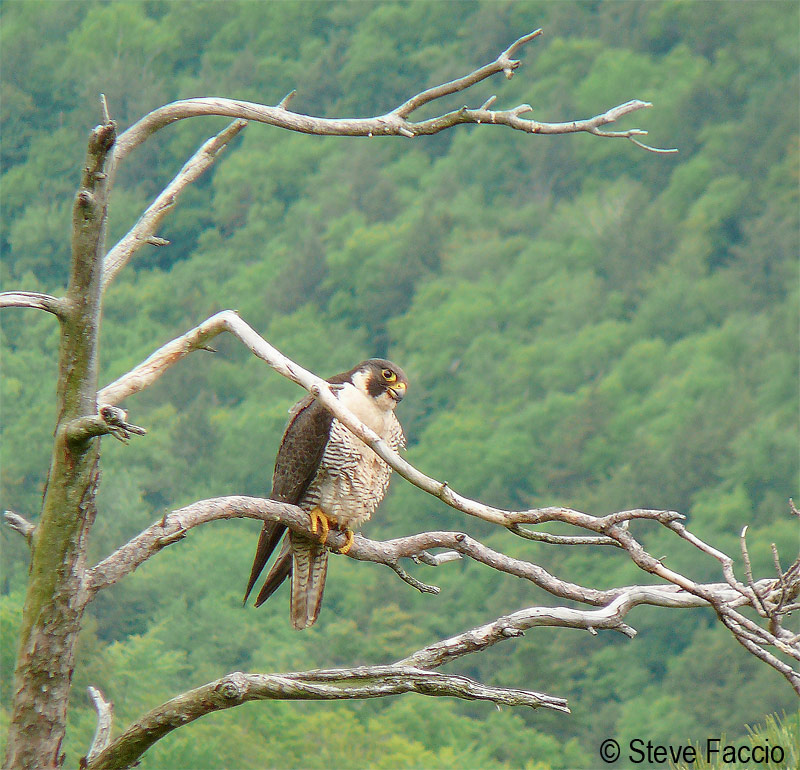A new VCE study tracks Peregrine Falcons at birth and at death
 One peregrine falcon, which hatched on a cliff in Salisbury, Vermont, died after eating a European starling that had been poisoned with a banned insecticide.
One peregrine falcon, which hatched on a cliff in Salisbury, Vermont, died after eating a European starling that had been poisoned with a banned insecticide.
Another collided with an airplane and died instantly on a runway in Fort Myers, Florida.
And yet another peregrine was shot and killed in Camaguey, Cuba, 1675 miles from where it fledged from a nest on a cliff at Acadia National Park in Maine.
The peregrine falcon’s return from near extinction to the skies of the eastern U.S. is one of the great wildlife conservation success stories of the past 50 years. But a new study illuminates, with occasional irony, how some of these swift birds of prey prematurely perish.
“What we learn about how falcons die helps us keep more falcons alive,” said Steven Faccio, a biologist at the Vermont Center for Ecostudies, which led the study published this fall in the Journal of Raptor Research.
Faccio and his colleagues studied the movements and fatalities of peregrine falcon nestlings fitted with distinctive leg bands at nests across New England from 1990-2009. Of the 986 falcons biologists banded during the study period, 238 were subsequently encountered again in the wild – 122 of these were found dead with their bands still intact. This gave the biologists a rare opportunity to link a falcon’s origins at a given nest site to the location and circumstances of its death.
For the majority of fatalities or fatal injuries the biologists could not with certainty determine a cause of death. But when the cause was obvious, airplane strikes accounted for most of the mortality. Fourteen falcons in the study were killed in such collisions. Open spaces of airport runways are attractive hunting grounds for falcons, which pursue and catch birds in flight. But avoiding airplanes is most likely not part of falcon evolution.
“We’re not saying that planes kill more falcons than anything else,” Faccio explained, “but when falcons and planes collide we’re more likely to know about them.”
The next most commonly recognized cause of death was falcons striking stationary objects, such as skyscrapers, windows, electric wires and bridge cables. Seven of the recovered birds were struck by trains and two others were hit by cars. Gunshots killed two additional falcons and one died after being tangled in fishing gear.
A disproportionate share of all the falcon deaths came in the first or second year of life, which is typical of wildlife, when younger individuals have not yet gained the adult’s wits for survival.
A two-year-old falcon banded at a nest site in Rochester, Vermont, for example, crashed into a chain-link fence while chasing prey and died 2,305 miles away in San Jacinto, Nicaragua. Peregrine falcons are known for far-flung travel. A villager who witnessed the death recovered the falcon, noted its leg band, and alerted a Peace Corps volunteer who went on to report the fatality.
For one other falcon, found dead by an ice climber in New York’s Adirondack Mountains, its last meal and likely cause of death was a European starling exposed to the pesticide fenthion. This adds irony to the results. Fenthion is banned from use across much of the nation, including New York. More than a half century ago, another insecticide, DDT, nearly pushed peregrine falcons to extinction.
A federal ban on DDT and a reintroduction program have returned peregrine falcons to the wild. The reintroduction program includes adding leg bands, each with a unique identification number, to nestlings. Later encounters with banded falcons – those either living or dead – give researchers insights into how they fare over time.
Faccio’s study also looked at the movements of surviving peregrine falcons, including how they disperse from their natal sites to other areas for nesting.
“Young birds wander widely and often get killed,” said Faccio. “But if they survive to see their second birthday, they’re likely to live to be seven, or eight, or even older.”
Survivorship and dispersal have allowed peregrine falcons to occupy new areas and habitats, human structures such as skyscrapers and bridges. These sites usually requires more management than cliff nests to ensure successful breeding, Faccio said, but has resulted in larger breeding distributions.
The study, titled “Movement Patterns, Natal Dispersal, and Survival of Peregrine Falcons Banded in New England,” included co-authors from the U.S Fish and Wildlife Service, Audubon Society of New Hampshire, Ecostudies Institute and Massachusetts Division of Fisheries and Wildlife.
Comments (3)
Pingbacks (2)
-
[…] How Falcons Die (vtecostudies.wordpress.com) […]
-
[…] How Falcons Die […]

We had a nesting pair here in North Hartland Dam, VT. for the last few years, but not this year. Question, do offspring return to their birth zone ?
we found two dead peregrine falcons this weekend at our home in Stockbridge. The first was found by the side of our house, but not near any large windows.
The second was found on the porch of our garage, next two sliding glass doors, but no sign of collision with window….one by the house was quite large, one by the garage maybe 70% of the size of the first one. Did not check to see if banded. Others finding similar occurance>
Interesting. Found a dead falcon in the rough on our golf course. Seemed a young bird.
? Struck by a passing airplane. There was a low flying Dakota yesterday.